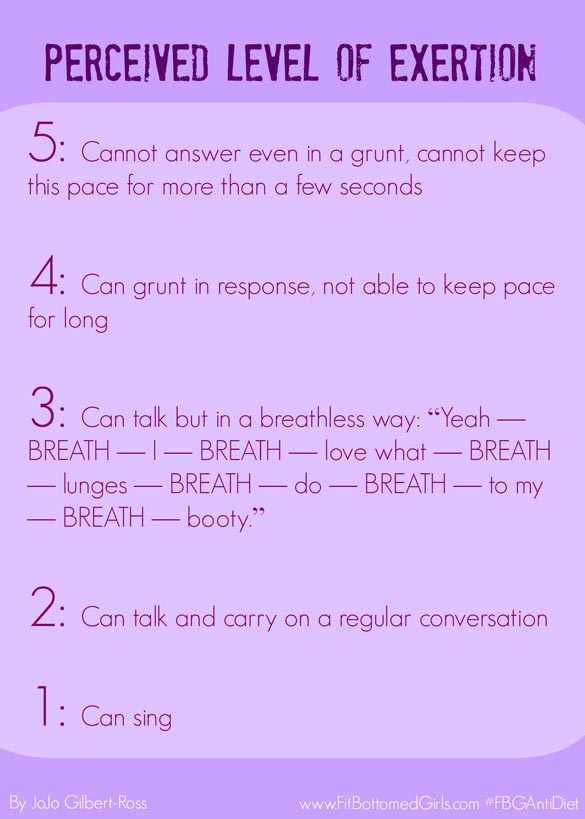Are You Working Out Hard Enough? An Easy Trick to Find Out!

Think you need a fancy heart-rate monitor or other device to see if you’re working out hard enough? While those can be amazeballs, something as simple as the Perceived Level of Exertion Scale can tell you if you’re working out hard enough — or too hard. To help explain what the heck the Perceived Level of Exertion Scale is and how to use it, we have a special guest post from JoJo Gilbert-Ross for New Year New Rear Week! JoJo is an Atlanta-based Operation Boot Camp instructor who likes campers to leave “sweaty and smiling.” Check out her camp on Facebook or her weekly tips on the Operation Boot Camp Decatur blog. And get ready to learn! —Jenn
How to Use the Perceived Level of Exertion Scale
When my wife and I started dating, one of our first conversations was about working out. I’m a fitness boot camp instructor, so working out always comes up. Usually, when I tell people what I do, they start confessing their workout and or eating sins, but my now wife said proudly: “I work out regularly on my lunch hour! I read scientific journals on the treadmill!” Now, being that it was early in our courtship, I gave her an approving smile and said “That’s great!” But what I was really thinking was: uh, that’s not really doing anything.
I know it sounds way harsh, Tai. It’s not that I was thinking that the only way to workout is what I do — wake up at 5:15 a.m. and run around outside doing push-ups, burpees, sit-ups and doing half marathons — it’s just that if she was going at a pace that allowed her to read, she just wasn’t working out hard enough to achieve her goals of balancing out her foodie habits and weekend fun; she wasn’t getting enough return on her workout for the amount of time she was putting into it.
Is this you? Are you putting in time on a workout that is getting you far fewer benefits than you could get doing something else for the same amount or even less time? My guess is your free time/workout time is pretty finite and therefore you would like to get the most out of it.
So how do you know if a workout is worth the amount of time you’re putting into it? Perceived level of exertion.
Perceived level of exertion (PLE) is a way to determine your intensity level when working out. It’s kind of like taking your workout’s temperature. The best thing about the PLE scale is its simplicity; you don’t need a heart rate monitor, calculator or chart to remember it.
To make sure you are working out at an intensity level that is worth your time and will help you reach your goals, use the scale below.
Using the scale as our reference, you should be in No. 3 and dabble in No. 4. A No. 5 is an all-out run-like-you-stole-it situation and is nice to have thrown in there but cannot be maintained for long.
High intensity interval training like Tabata is the PLE scale’s bread an’ buddah’— there’s no easier way to work that scale like yo’ mama wished you would’ve during piano practice. Mixing up your runs with some speed play is another high-five for PLE. Use street lights or mailboxes to cue you to speed up or slow down. Sprint two, run one, jog one, repeat or — even easier — add a few hills in. An added benefit of high intensity interval training is that it keeps you burning calories long after your workout. That’s like Clinque bonus time all day, baby!
What’s your go-to workout when you have just a wee bit of time? Have you found a workout that does a good job of working the perceived level of exertion scale? —JoJo Gilbert-Ross

